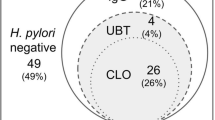Abstract
Background
The diagnosis of Helicobacter pylori is an essential element in the management of many common gastrointestinal pathologies. Previously diagnosis was dependent on the availability of endoscopic biopsy samples. The advent of non invasive assays such as the C13Urea breath test and Elisa serology have enabled diagnosis, and treatment to be undertaken in the primary care setting. The isolation of Helicobacter pylori antigen from stool has led to the development of a new non-invasive test.
Aim
A prospective study was designed to assess and compare the performance of Premier Platinum HpSA with current gold standard tests.
Methods
Consecutive patients undergoing a gastroscopy for investigation of dyspepsia at the Meath and Adelaide hospitals were enrolled. At endoscopy gastric biopsies were taken for histology, microbiology and rapid urease testing. In addition all subjects had C13UBT, serology and stool tests performed. Individuals who were H. pylori positive received standard proton pump inhibitor based triple therapy. Following treatment all tests, apart from serology were repeated.
Results
54 patients were enrolled, 46 per cent were H. pylori positive. HpSA had a sensitivity and specificity and positive and negative predicted values of 96 per cent, 75 per cent and 80.6 per cent, 75.8 per cent respectively and compared favourably with all other tests. The sensitivity and specificities of the other tests were, histology 79.2 per cent and 100 per cent, culture 68 per cent and 100 per cent, rapid urease test 75 per cent and 100 per cent, serology 75 per cent and 96 per cent and C13 urea breath test 100 per cent and 96.6 per cent.
Conclusion
The detection of H. pylori antigen in stool by means of a HpSA assay is a new and effective non-invasive means of diagnosis which can be performed in a routine laboratory setting. It is simple to perform and has possible advantages over other non-invasive tests, detecting actual antigen indicating current active infection.
Similar content being viewed by others
References
Buckley, M. J. M., O’Shea, G. A. et al. A community based study of the epidemiology of Helicobacter pylori infection and associated gastroduodenal pathology. Eur. J. Gastroenterol. and Hepatol. 1998; 110(5): 375–381.
NIH Consensus Development Panel on Helicobacter pylori in peptic ulcer disease. Helicobacter pylori in peptic ulcer disease. JAMA 1994; 272: 65–69.
International Agency for Research on Cancer. Schistosomes, liver fluke and Helicobacter pylori. IARC Monographs on the evaluation of carcinogenic risks to humans. 1994; 61: 218–220.
Laheij, R. J. F., Jansen, B. M. J. Van De Lisdonk, E. H. et al. Review article: Symptom improvement through eradication of Helicobacter pylori in patients with non-ulcer dyspepsia. Aliment Pharmacol. Ther. 1996; 10: 843–850.
Talley, N. J., Colin-Jones, D., Neyreno, K. M. et al. Functional dyspepsia, a classification and guidelines for diagnosis and management. Gastroenterol. 1991; 4: 45–60.
Jones, R. H. Clinical economics review: gastrointestinal disease in primary care.
Rosenstock, S., Kay, L., Rosenstock, C. et al. Relation between Helicobacter pylori infection and gastrointestinal symptoms and syndromes. Gut 1997; 41(2): 169–176.
The European Helicobacter pylori Study Group. Current European concepts in the management of Helicobacter pylori infection. The Maastricht consensus report. Gut 1997; 41: 8–14.
Logan. R. P. H. The 13C urea breath test. In: Lee, A., Megraud, F. Helicobacter pylori: technique for clinical diagnosis and basic research. Ed: Saunders Company Ltd. 1996; 74–81.
Thomas, J. E., Gibson, J. R., Darboe, M. K. et al. Isolation of Helicobacter pylori from human faeces. Lancet 1992; 340: 1194–1195.
Author information
Authors and Affiliations
Rights and permissions
About this article
Cite this article
McNamara, D., Whelan, H., Hamilton, H. et al. HpSA: Assessment of a new non-invasive diagnostic assay for helicobacter pylori infection in an Irish population. Ir. J. Med. Sci. 168, 111–113 (1999). https://doi.org/10.1007/BF02946478
Issue Date:
DOI: https://doi.org/10.1007/BF02946478




